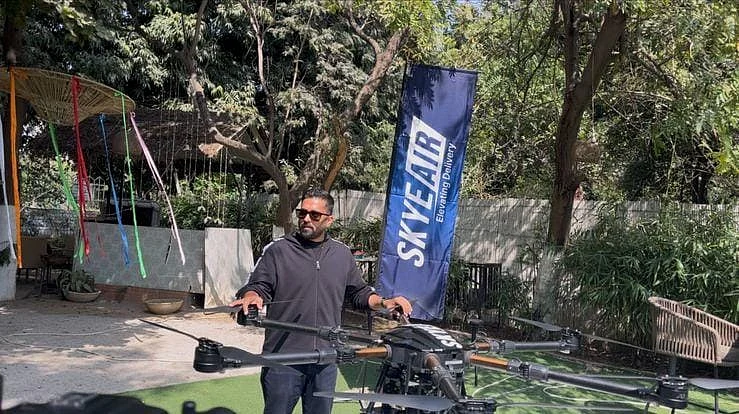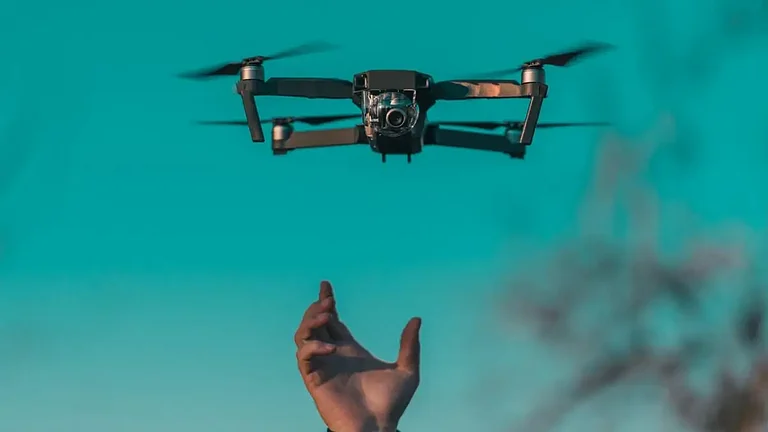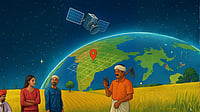Skye Air is all set for its biggest funding round yet, following its series A in April 2024. The drone delivery company has partnered with the top logistic players in the fast-growing quick-commerce, previously raised funding in 2021 and 2022.
Speaking with Outlook Business, Ankit Kumar, CEO & Founder of Skye Air Mobility, shared that despite the availability of multiple delivery options, he observed inefficiencies in last-mile logistics and a significant accessibility gap in remote regions of the country. This led to the inception of Skye Air.
Edited Excerpts:
What was the idea behind setting up a drone delivery company?
The idea for Skye Air was triggered by the inefficiencies I observed in last-mile logistics and the significant accessibility gap in remote regions of the country. In many far-off areas, especially in places like Himachal Pradesh, seasonal challenges such as heavy snowfall lead to roadblocks, cutting people off from essential supplies. In today’s hyper-connected world, even a short delay in reaching loved ones can cause distress—imagine being completely isolated for 10–11 days without access to medicines or emergency supplies.
With this in mind, we set out to improve accessibility in these remote areas, aiming to make them as connected as urban regions in developed countries. Our approach started with last-mile delivery, where we noticed inefficiencies not just in terms of time but also in the way deliveries were being executed.
Additionally, we observed high levels of wastage and pilferage in logistics hubs, particularly in the e-commerce and quick-commerce sectors. To address these challenges, we realized that vertical transportation could be a game-changer.
Since you entered the delivery sector, you are competing with well-established quick e-commerce companies. What challenges have you encountered in this highly competitive market?
Today, everyone is competing to promise deliveries within 10 or 15 minutes. But rather than competing with them, we see ourselves as an enabler—an add-on that enhances their efficiency.
For example, while I can’t name the client, we work with one of the largest quick commerce companies in Gurgaon. Initially, we were handling around 100 package deliveries per day from a single dark store. Through our system, we optimized the process by batching 40% of the packages. This meant that instead of making 40 separate trips for 40 packages—like a traditional rider would—we completed the deliveries in just 20 drone flights, each carrying two packages.
Currently, customers pay platform fees, delivery charges, and other associated costs. However, as drone adoption increases, these costs will decrease, making last-mile delivery more affordable and efficient for both businesses and consumers.
You mentioned that you started this to improve accessibility for customers. Do you plan to expand into rural areas in India as well?
It's not just about the products or accessibility—it's also about repeated demand. We've realized that drone delivery makes the most sense for users who need frequent deliveries, not just occasional ones. If you only need something once a week or even once a day, you might not be the ideal user. But if you require deliveries multiple times a day, daily, or even several times a week, then drones become a viable and valuable solution. Rural areas are not ideal in that sense for us.
As you are suggesting that drone delivery will be more affordable than existing quick commerce services for consumers.Then, how do you perceive the potential for your products in the global market?
There are only a few companies globally working on drone deliveries, but most of them are focused on suburban or rural areas. In the U.S., there's a company doing this; in Switzerland, there's Matternet; and in Ireland, another company is operating in small counties and remote locations, delivering directly to doorsteps.
However, what I firmly believe—and what has been proven with various technologies—is that if something works in India, it can work anywhere. That belief shaped our approach. If we can successfully deploy drone deliveries in a densely populated area like Gurgaon, then scaling it globally becomes much easier.
The delivery sector is a major source of employment in the country. Do you think your product and company could potentially disrupt jobs in this space, or will it create new opportunities?
This isn't just about making life easier for customers—it’s also a game-changer for delivery riders.
Imagine you’re a typical delivery rider. Every day, you wake up focused on earning. You rush between Zomato, Zepto, and other deliveries, making Rs 800–900 daily. But after deducting fuel, bike maintenance, and fines from rash driving, your real savings drop to Rs 500.
Now, here’s what we offer: Become a Skywalker. No bike, no fuel, no stress. Just manage deliveries within a residential complex—picking up 30–40 packages from a pod and delivering within the premises. You still earn Rs 800–900 daily, but with zero expenses and no uncertainty.
Unlike traditional gig work, where daily earnings fluctuate, we ensure consistent deliveries and stable income. For example, in our October campaign, one Skywalker earned significantly more with less effort and zero overheads.
Could you share some insights into your current business performance, including the revenue trends and customer policies?
We collaborate with numerous private companies across e-commerce, quick commerce, and logistics. In the e-commerce space, we work with Shiprocket, which aggregates packages from brands like boAt, Puma, and various D2C brands.
In quick commerce and logistics, we partner with several key players—though many remain undisclosed. Our partnerships span across multiple sectors, ensuring seamless and efficient deliveries. From the start, we focused on building a proven business model before seeking investment. Our first funding round happened in 2021, followed by another in 2022, and our Series A in April 2024. Now, we're gearing up for a larger funding round.
Unlike some, we aren't relying on subsidies or grants to build our business. However, the government has been proactive in easing drone regulations, making commercial operations more viable.
What we do anticipate is government support for end users—especially farmers. Today, transporting goods by road is significantly cheaper than using drones. If subsidised, farmers could benefit from faster and more efficient deliveries.






























